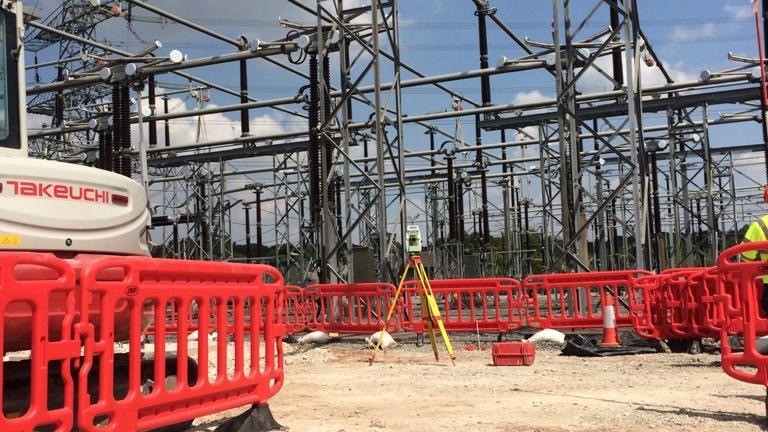Powers was appointed by JB Towers Solutions to set out a new shunt reactor at the Weaver Island Substation, located in Frodsham. Accurate setting out was essential during the initial stages of construction, to enable development to get under way. Throughout the project, the substation remained live, with 400kV running through it. This created health and safety risks, which the Powers team had to mitigate against, including working within defined areas and monitoring the weather closely, as if it rained, the team had to evacuate quickly. Powers completed the project, without compromising on health and safety standards, accuracy or efficiency, even when the team was required to proceed with caution.
The project
Weaver Island Electrical Substation is in Frodsham, within the vicinity of the River Weaver. Frodsham is a market town in Cheshire West & Cheshire, in the Northwest of England. Once a thriving port, the town now enjoys views across the Mersey Estuary. This engineering project at Weaver Island Substation involved the creation of a new shunt reactor.
JB Towers Solutions was engaged by National Grid to undertake the upgrading of the electrical work at the substation, including the installation of a new shunt reactor. JB Tower Solutions is a specialist consultancy working in the mast and towers industry. The company specialises in delivering technical and innovative engineering solutions, specifically for the telecoms and broadcast markets.
A shunt reactor absorbs reactive power, which increases the energy efficiency of the generation system. It is the most compact device commonly used for reactive power compensation in long high-voltage transmission lines and cable systems.
Our involvement
Powers’ expertise was called on by JB Towers for the setting out stage of the project. The Powers team began work in June 2021, with its engineers involved in a great deal of complicated setting out on the site.
The surveyors had to set out two new transformers next to the existing 180 tonne transformers, along with new boundary fencing. They also had to set out additional vertical points to connect to the overhead horizontal busbars that distribute high power electrical current from the National Grid. No metal tapes could be used in this area due to the possibility of an electrical arc catching the tape and electrocuting the surveyor below. Finally, the team was required to set out the base centres for new electricity pylons, which were to be erected near to the substation.
The challenges
The complicated nature and increased health and safety measures required from the substation layout meant Powers’ surveyors had to crosscheck and doublecheck the information they were provided with – and their own work and positioning – to millimetre accuracy. Special permits also had to be secured and were required by operatives for any area of the site.
The Powers team only had limited access to the site and wore fire retardant PPE at all times, as the health and safety risks were immense, due to the dangerous nature of the site contents. This included high-energy cabling and overhead equipment, which was prevalent across the site. Powers’ surveyors also had to be in constant communication with the Met Office, as site evacuation was required if any thunderstorms or lightening was forecast within a 10-mile radius.
The outcome
All work at the substation was successfully carried out. Due to the nature of the site, Powers had to carry out enhanced and dynamic Health & Safety risk assessments, to ensure that its staff and their equipment were safe, while working in such conditions.
Collaboration and communication with the client – and others involved with the project – was key to the work’s success and the safety of the team.
“We found Powers’ engineers to be professional and vigilant when it came to working at Weaver Island Substation. The site was complicated and it’s not the usual site conditions to be working under – in fact it can feel quite pressured. Extra care was needed, and Powers’ engineers proceeded with caution, without sacrificing accuracy and efficiency.”
Hugh Brennan, JB Towers Solutions









